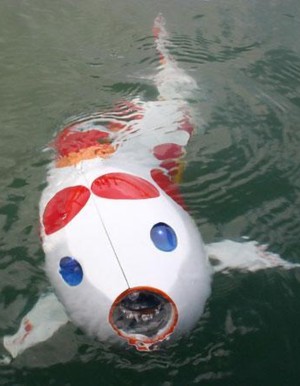
An Actroid is a humanoid robot with strong visual human-likeness developed by Osaka University and manufactured by Kokoro Company Ltd. (the animatronics division of Sanrio). It was first unveiled at the 2003 International Robot Exposition in Tokyo, Japan. Several different versions of the product have been produced since then. In most cases, the robot's appearance has been modeled after an average young woman of Japanese descent.
The Actroid woman is a pioneer example of a real machine similar to imagined machines called by the science fiction terms android or gynoid, so far used only for fictional robots. It can mimic such lifelike functions as blinking, speaking, and breathing. The "Repliee" models are interactive robots with the ability to recognise and process speech and respond in kind.
Technology
Internal sensors allow Actroid models to react with a natural appearance by way of air actuators placed at many points of articulation in the upper body. Early models had 42 points of articulation, later models have 47. So far, movement in the lower body is limited. The operation of the robot's sensory system in tandem with its air powered movements make it quick enough to react to or fend off intrusive motions, such as a slap or a poke. Artificial intelligence possessed by the android gives it the ability to react differently to more gentle kinds of touch, such as a pat on the arm.
The Actroid can also imitate human-like behavior with slight shifts in position, head and eye movements and the appearance of breathing in its chest. Additionally, the robot can be "taught" to imitate human movements by facing a person who is wearing reflective dots at key points on their body. By tracking the dots with its visual system and computing limb and joint movements to match what it sees, this motion can then be "learned" by the robot and repeated.
The skin is composed of silicone and appears highly realistic. The compressed air that powers the robot's servo motors, and most of the computer hardware that operates the A.I., are external to the unit. This is a contributing factor to the robot's lack of locomotion capabilities. When displayed, the Actroid has always been either seated or standing with firm support from behind.
The interactive Actroids can also communicate on a rudimentary level with humans by speaking. Microphones within those Actroids record the speech of a human, and this sound is then filtered to remove background noise - including the sounds of the robot's own operation. Speech recognition software is then used to convert the audio stream into words and sentences, which can then be processed by the Actroid's A.I. A verbal response is then given through speakers external to the unit.
Further interactivity is achieved through non-verbal methods. When addressed, the interactive Actroids use a combination of "floor sensors and omnidirectional vision sensors" in order to maintain eye contact with the speaker. In addition, the robots can respond in limited ways to body language and tone of voice by changing their own facial expressions, stance and vocal inflection.

